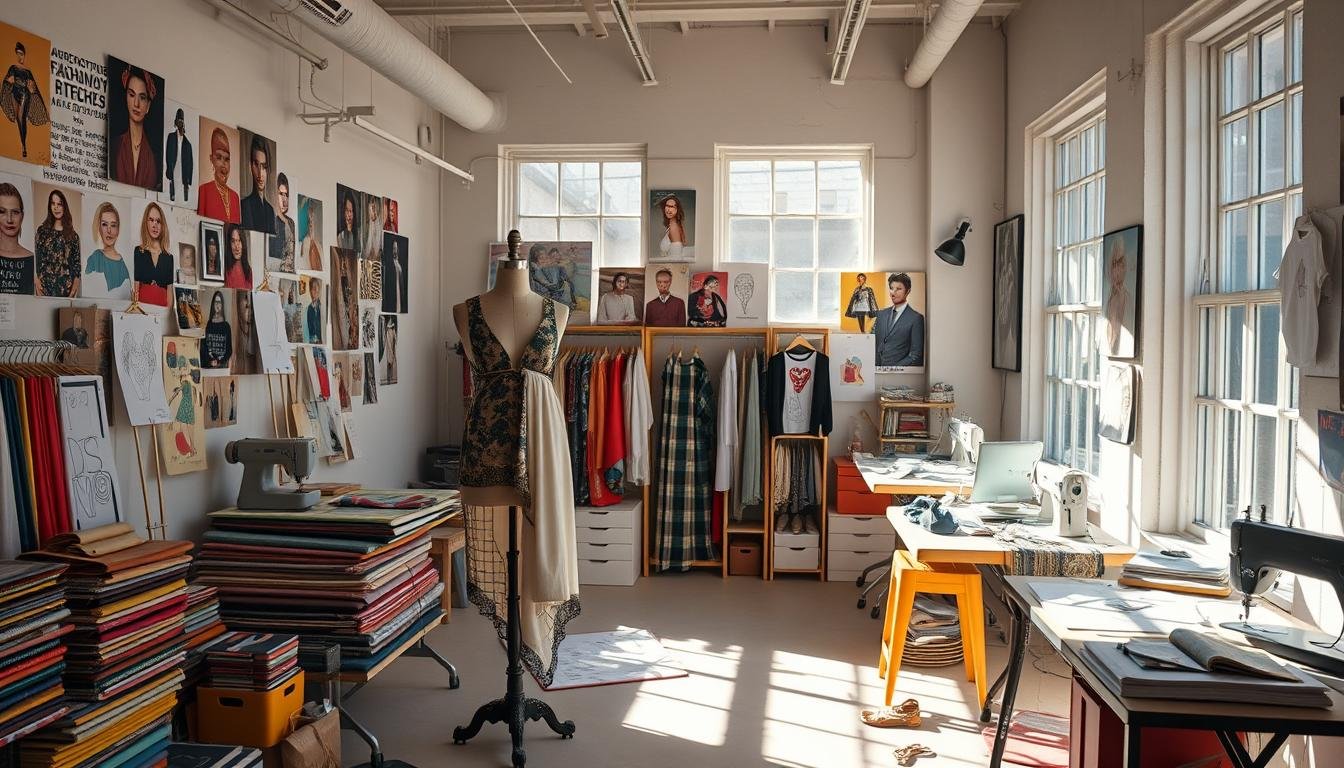Unlock your creative potential and start an exciting journey in fashion design. This course will teach you how to make stunning clothes and accessories. You’ll learn from experts and get hands-on experience in the fashion world.
You’ll dive into trend analysis, technical sketching, and pattern making. These skills are key to understanding modern fashion.
Key Takeaways
- Develop your unique fashion design skills and create visually captivating garments
- Learn from industry experts and gain hands-on experience in the fashion design process
- Explore the diverse aspects of the fashion industry, including trend analysis and pattern making
- Unlock your creative potential and discover your personal style in fashion design
- Prepare for a rewarding career in the dynamic and ever-evolving world of fashion
Introduction to Fashion Designing
Fashion designing is the art of making clothes and accessories that look good and serve a purpose. We’ll explore the basics of fashion design and why having your own style is key in this field.
What is Fashion Designing?
Fashion designing is about creating new fashion pieces that show off a designer’s vision. It covers women’s fashion, men’s fashion, and everything in between. From high-end couture to everyday clothes, it’s all about bringing ideas to life.
The Importance of Developing Your Style
In the fast-changing world of fashion designing, having your own style is essential. By improving your fashion designing skills, you can make designs that grab people’s attention. Whether you like bold statements or classic looks, expressing yourself through fashion is what makes you stand out.
“Fashion is not something that exists in dresses only. Fashion is in the sky, in the street, fashion has to do with ideas, the way we live, what is happening.”
Starting your fashion designing journey means bringing your unique view and style to life. By learning the basics of fashion designing and sharpening your creative skills, you’ll make a big impact in the fashion world.
Exploring Different Fashion Styles
The fashion world is full of diverse styles, each with its own charm. From classic couture gowns to streetwear’s edgy look, there’s something for everyone. Exploring these styles helps us understand their evolution.
Fashion reflects cultural influences in a unique way. Traditional clothes like the sari and kimono inspire designers globally. Learning about these traditions deepens our appreciation for fashion’s history and symbolism.
Societal trends also shape the fashion industry. For example, athleisure’s rise focuses on comfort and casual wear. The sustainability movement promotes eco-friendly and ethical fashion brands.
Exploring fashion styles keeps our minds open to creativity. Whether you love high-fashion elegance or punk’s boldness, there’s always something new to find and be inspired by.
https://www.youtube.com/watch?v=ApDUqEyn6M0
“Fashion is not something that exists in dresses only. Fashion is in the sky, in the street, fashion has to do with ideas, the way we live, what is happening.”
– Coco Chanel, legendary fashion designer
Understanding Fashion Trends
In the world of fashion, it’s key to stay ahead. Designers, stylists, and fans need to know the latest trends. This way, you can predict the next big thing and create a unique style that stands out.
Current Fashion Trends
Fashion trends change fast, from Paris to New York. Right now, 90s styles and bright colors are back. Also, eco-friendly fashion is growing, as people care more about the planet.
How to Stay Ahead of the Curve
To stay ahead, you need to watch trends closely. Here are some tips:
- Follow fashion bloggers, designers, and leaders on social media.
- Go to fashion shows, events, and conferences to see new styles.
- Buy timeless pieces that you can update with new accessories.
- Try new things with your style and be bold – you might start a trend!
Developing Your Personal Style
Creating a personal fashion style is a fun journey of self-discovery. First, you need to know your body type. This helps you pick the right colors, fabrics, and shapes that look good on you and show off your style.
Identifying Your Body Type
Understanding your body shape is key to your personal style. Are you pear-shaped, apple-shaped, hourglass, or athletic? Knowing your shape lets you choose clothes that highlight your best features and hide the ones you’re not as fond of.
Choosing Colors and Fabrics
Colors and fabrics are crucial in your style. The right ones can make you look and feel amazing. Try out different colors and fabrics to find what makes you feel confident and comfy. See how different elements can come together to make a stylish and practical outfit.
| Body Type | Flattering Colors | Recommended Fabrics |
|---|---|---|
| Pear-shaped | Blues, greens, blacks | Stretch fabrics, A-line silhouettes |
| Apple-shaped | Reds, oranges, whites | Lightweight, flowing fabrics |
| Hourglass | Jewel tones, neutrals | Structured, tailored fabrics |
| Athletic | Pastels, earth tones | Drapey, textured fabrics |
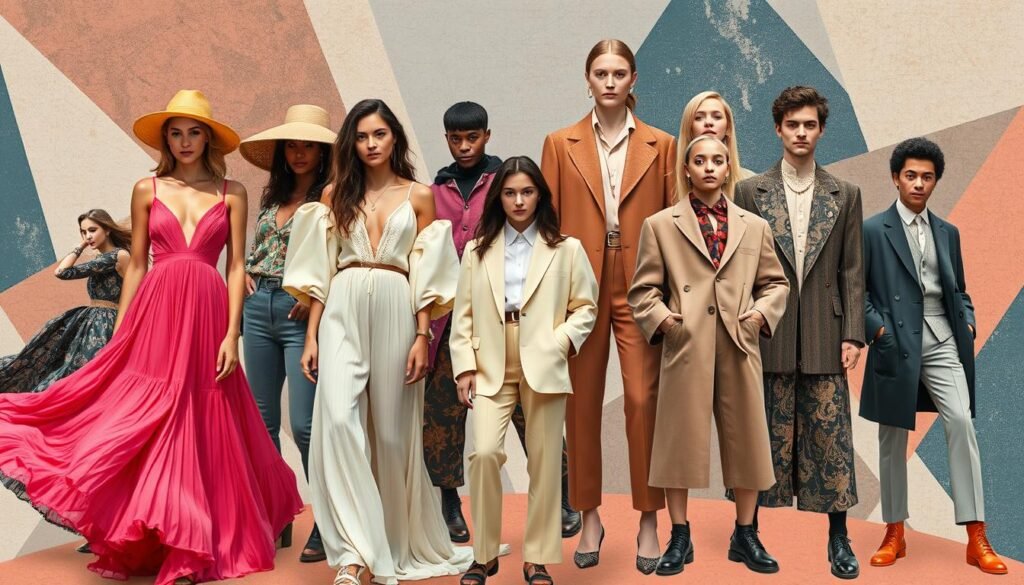
“Developing your personal style is not about following trends, but about expressing your unique identity through fashion.”
By understanding your body type and trying out different colors and fabrics, you can create a fashion style that’s truly yours. This journey will not only improve your fashion skills but also make you feel more confident and comfortable in your own skin.
The Elements of Fashion Design
Fashion design is a complex field that includes many elements. It ranges from sketching to making clothes. Understanding these basics is key for anyone interested in fashion.
The Principles of Design
The core of fashion design is the principles of design. These are balance, rhythm, emphasis, proportion, and harmony. Knowing these principles helps designers create beautiful and well-made clothes.
Color and Texture
Color and texture are crucial in fashion design. The right colors can make a collection feel certain ways. Fabrics’ texture also affects how clothes look and feel. Trying out different colors and textures is important for creating unique designs.
Technical Skills
Designers need both creative and technical skills. They must know how to sketch, make patterns, and sew clothes. Learning sewing, draping, and tailoring is essential. It helps turn ideas into real clothes.
Exploring fashion design’s elements helps you understand its complexity. Whether you want to design clothes or just love fashion, learning these basics is vital. It gives you the skills to make amazing and new designs.
Fashion Designing Course: An Overview
Start your journey in fashion design with our fashion designing course. It’s packed with skills and knowledge for the fashion world.
Course Curriculum
Learn from the basics to advanced techniques in pattern making and garment construction. You’ll dive into color theory, textile selection, and silhouette development. This will give you a solid grasp of fashion elements.
Practical Assignments and Projects
- Work on projects that let you use your fashion designing skills to create your designs.
- Take on design challenges that mimic real-world scenarios. This sharpens your problem-solving and decision-making.
- Join group projects to improve teamwork and communication. These skills are key in the fashion industry.
This fashion designing course mixes theory and practice. It helps you find your design style and prepares you for a career in fashion.
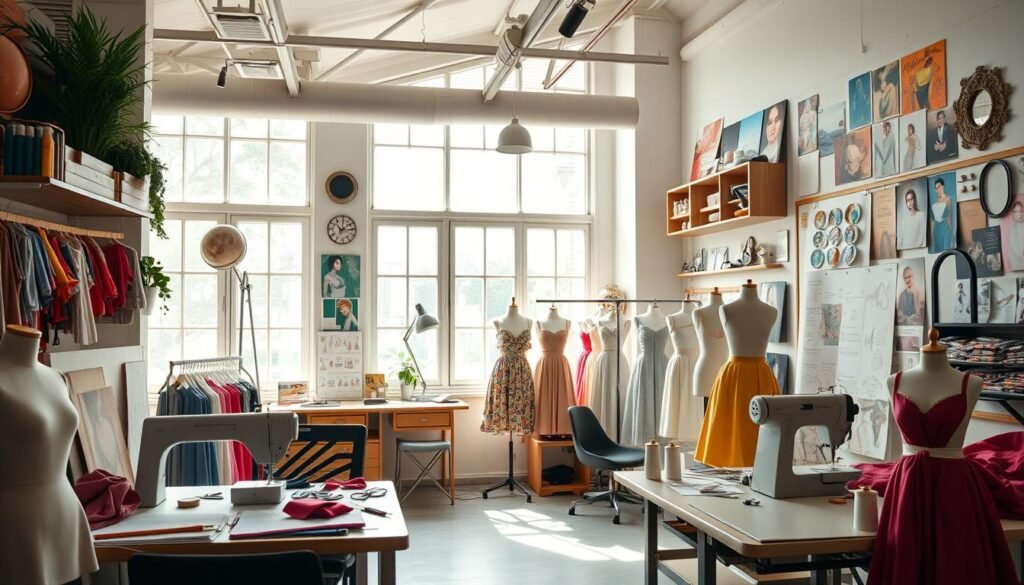
“This program has been a game-changer for me. The hands-on projects and industry-relevant curriculum have truly elevated my fashion designing skills.”
| Course Modules | Duration |
|---|---|
| Introduction to Fashion Design | 4 weeks |
| Design Fundamentals and Sketching | 6 weeks |
| Pattern Making and Draping | 8 weeks |
| Garment Construction and Sewing | 6 weeks |
| Fashion Trends and Forecasting | 4 weeks |
fashion designing course
Joining a fashion designing course is a smart move for your creative career. This program gives you the tools and knowledge to make your fashion dreams come true. You’ll learn both theory and practice, understanding the fashion design process and how to make your designs real.
The course covers key topics like:
- Fashion design fundamentals – Learn design principles, color theory, and silhouette.
- Textile and material studies – Discover fabrics and materials’ properties and uses.
- Garment construction and pattern making – Get skilled in draping, cutting, and sewing.
- Trend forecasting and analysis – Understand fashion trends and how to stay ahead.
- Branding and marketing – Learn to promote and market your designs.
You’ll work with industry pros, join fashion shows, and show your work to employers. This hands-on learning prepares you for the fast-paced world of fashion designing.
“The fashion designing course has been a transformative experience, allowing me to explore my creative passions and develop the practical skills needed to turn my design dreams into reality.”
Whether you want to be a fashion designer or just improve your style, this course is a great investment. It opens doors to new opportunities and lets you show your artistic side.
Choosing the Right Fashion Design School
Choosing the right fashion design school is a big decision. It can greatly affect your future career. When looking for a fashion designing course, think about what you want and what you need.
Factors to Consider
When looking at fashion design schools, consider a few key things:
- Reputation and accreditation of the school
- Curriculum and course offerings in fashion designing
- Qualifications and expertise of the faculty
- Access to industry resources, such as internships and networking opportunities
- Facilities and equipment available for hands-on learning
- Tuition fees and financial aid options
Top Fashion Design Schools
India has many top fashion design schools. These schools are known for preparing students well for the industry. Some of the best fashion designing course providers in India are:
| School | Location | Specialization | Notable Alumni |
|---|---|---|---|
| National Institute of Fashion Technology (NIFT) | Multiple Campuses | Fashion Design, Textile Design, Accessory Design | Manish Malhotra, Masaba Gupta, Anju Modi |
| Pearl Academy | Multiple Campuses | Fashion Design, Fashion Business, Jewelry Design | Rahul Mishra, Masaba Gupta, Anita Dongre |
| Symbiosis Institute of Design | Pune | Fashion Design, Interior Design, Communication Design | Payal Khandwala, Varun Bahl, Shruti Sancheti |
By looking at these top fashion designing course providers, you can make a smart choice. This choice will help you start a fulfilling career in fashion design.
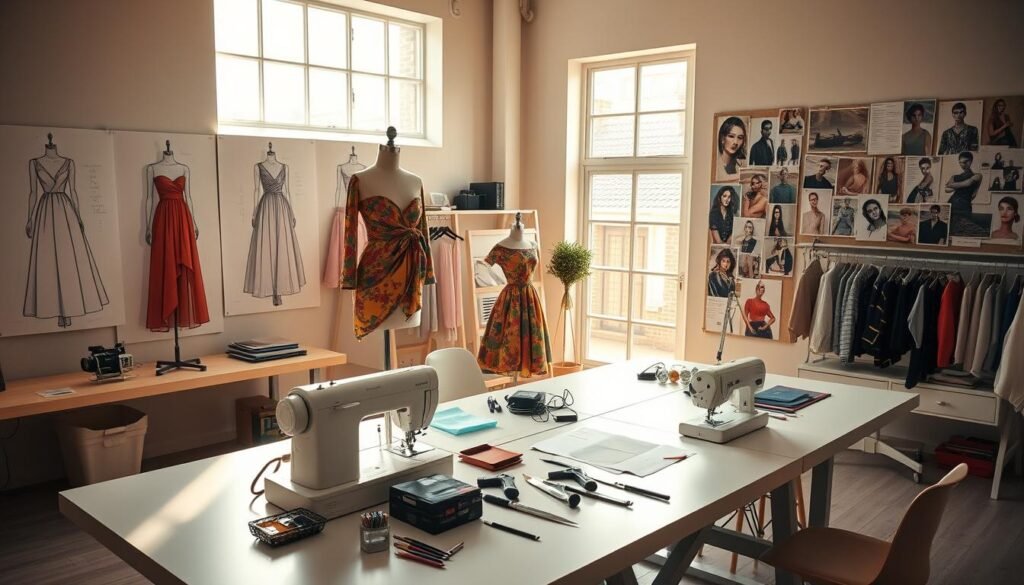
Career Opportunities in Fashion Design
Starting a fashion designing course opens many doors in the fashion world. You could work for big brands, start your own line, or explore styling, textile design, merchandising, or journalism. The choices are endless.
As a fashion design graduate, you can use your creativity and skills in many ways. Here are some roles you might find interesting:
- Fashion Designer – Create amazing clothes and accessories for famous brands or your own label.
- Textile Designer – Make new fabric designs and patterns that lead the fashion trends.
- Fashion Stylist – Plan and organize stylish outfits for photoshoots, big events, and famous people.
- Fashion Merchandiser – Handle the business side of fashion, like product development, marketing, and sales.
- Fashion Journalist – Share your love for fashion by writing about the latest trends, designer collections, and industry news.
With a good fashion designing course and a love for style, the fashion world is full of chances. You can make your creative dreams come true and have a rewarding career. Look into all the paths you can take and let your fashion dreams soar.
Building Your Fashion Design Portfolio
As a fashion designer, your portfolio is your masterpiece. It shows your creativity, technical skills, and style. A great portfolio is key to getting your dream job or starting your own label.
Tips for Creating a Captivating Portfolio
To impress employers or clients, follow these tips:
- Choose your best work: Pick your top fashion sketches, drawings, mood boards, and designs to show your range.
- Show your design process: Include sketches, fabric swatches, and behind-the-scenes elements to show your careful design approach.
- Highlight your unique style: Make sure your portfolio shows your personal style and design philosophy, making you stand out.
- Organize your work well: Arrange your portfolio in a way that looks good and flows well.
- Keep it focused: Only show your strongest and most relevant pieces to keep your portfolio professional.
Your fashion design portfolio is your chance to show off your skills and creativity. By following these tips, you’ll make a portfolio that will help you shine in the fashion designing course and industry.
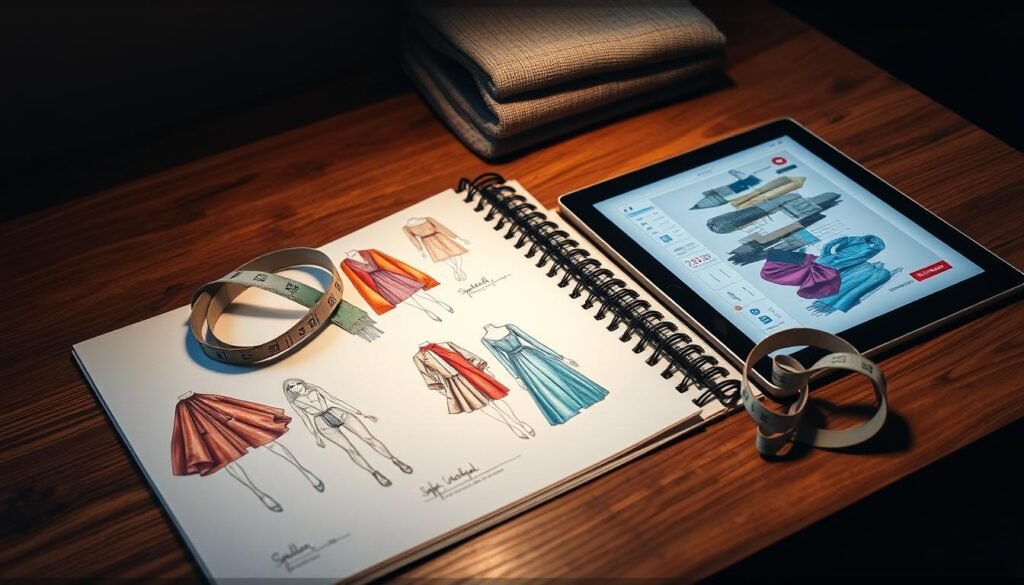
“Your portfolio is a reflection of your passion, creativity, and dedication to the craft of fashion design. Make it count.”
| Key Elements of a Successful Fashion Design Portfolio | Description |
|---|---|
| Technical Sketches | Detailed drawings that show your technical skills and garment construction knowledge |
| Fashion Illustrations | Vibrant, expressive illustrations that show your unique artistic style |
| Mood Boards | Visual collages that show your design inspirations and color/fabric choices |
| Final Garment Designs | Completed designs that show you can turn ideas into real products |
Networking and Internships
Aspiring fashion designers know how key networking and internships are. These elements are vital for success in the fashion world. They help us grow and learn.
Networking is essential in the fashion industry. It helps us meet experienced designers and influencers. This opens doors to great opportunities. By going to fashion events and workshops, we meet new people and build important relationships.
Internships give us real-world experience in fashion designing. Working at top fashion houses or studios, we learn by doing. We get to see how designs come to life. Internships can lead to jobs, showing off our skills and building our portfolios.
- Attend fashion industry events and networking sessions to connect with professionals.
- Leverage your existing connections and reach out to industry contacts for potential internship opportunities.
- Research and identify leading fashion design studios or brands that align with your aspirations and interests.
- Prepare a compelling resume and portfolio to showcase your fashion designing course experience and creative talents.
- Proactively communicate with potential internship hosts and follow up on application submissions.
By using networking and internships, we open doors to success. We gain insights and position ourselves for the future in fashion designing.
“Networking is the single most powerful marketing tactic to grow any business.” – Tim Ferriss
Conclusion
The fashion designing course you’ve started is more than a career path. It’s a journey of self-discovery and creativity. You’ll learn to develop your unique style and stand out in the fashion world.
As you finish your studies, get ready for what’s next. Keep pushing your creativity to new heights. The fashion industry offers endless possibilities.
This course has given you the skills and confidence to make your mark. Whether you dream of designing luxury gowns or sustainable fashion, you’re ready. Embrace challenges, celebrate wins, and explore the fashion world’s endless possibilities.
